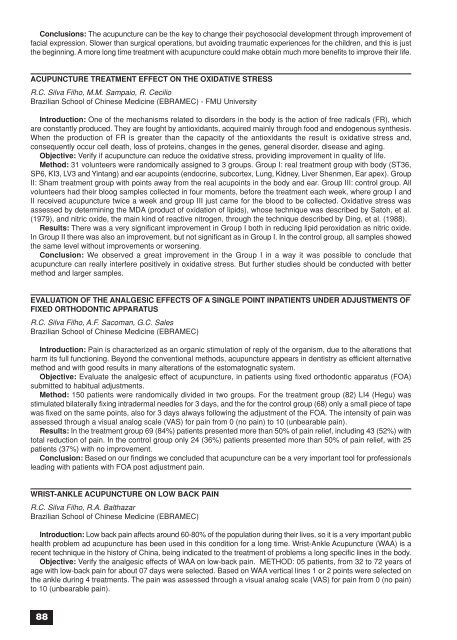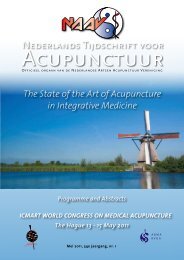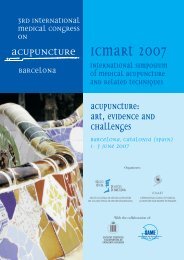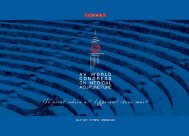Congress Abstracts full PDF - International Council of Medical ...
Congress Abstracts full PDF - International Council of Medical ...
Congress Abstracts full PDF - International Council of Medical ...
You also want an ePaper? Increase the reach of your titles
YUMPU automatically turns print PDFs into web optimized ePapers that Google loves.
Conclusions: The acupuncture can be the key to change their psychosocial development through improvement <strong>of</strong><br />
facial expression. Slower than surgical operations, but avoiding traumatic experiences for the children, and this is just<br />
the beginning. A more long time treatment with acupuncture could make obtain much more benefits to improve their life.<br />
ACUPUNCTURE TREATMENT EFFECT ON THE OXIDATIVE STRESS<br />
R.C. Silva Filho, M.M. Sampaio, R. Cecilio<br />
Brazilian School <strong>of</strong> Chinese Medicine (EBRAMEC) - FMU University<br />
Introduction: One <strong>of</strong> the mechanisms related to disorders in the body is the action <strong>of</strong> free radicals (FR), which<br />
are constantly produced. They are fought by antioxidants, acquired mainly through food and endogenous synthesis.<br />
When the production <strong>of</strong> FR is greater than the capacity <strong>of</strong> the antioxidants the result is oxidative stress and,<br />
consequently occur cell death, loss <strong>of</strong> proteins, changes in the genes, general disorder, disease and aging.<br />
Objective: Verify if acupuncture can reduce the oxidative stress, providing improvement in quality <strong>of</strong> life.<br />
Method: 31 volunteers were randomically assigned to 3 groups. Group I: real treatment group with body (ST36,<br />
SP6, KI3, LV3 and Yintang) and ear acupoints (endocrine, subcortex, Lung, Kidney, Liver Shenmen, Ear apex). Group<br />
II: Sham treatment group with points away from the real acupoints in the body and ear. Group III: control group. All<br />
volunteers had their bloog samples collected in four moments, before the treatment each week, where group I and<br />
II received acupuncture twice a week and group III just came for the blood to be collected. Oxidative stress was<br />
assessed by determining the MDA (product <strong>of</strong> oxidation <strong>of</strong> lipids), whose technique was described by Satoh, et al.<br />
(1979), and nitric oxide, the main kind <strong>of</strong> reactive nitrogen, through the technique described by Ding, et al. (1988).<br />
Results: There was a very significant improvement in Group I both in reducing lipid peroxidation as nitric oxide.<br />
In Group II there was also an improvement, but not significant as in Group I. In the control group, all samples showed<br />
the same level without improvements or worsening.<br />
Conclusion: We observed a great improvement in the Group I in a way it was possible to conclude that<br />
acupuncture can really interfere positively in oxidative stress. But further studies should be conducted with better<br />
method and larger samples.<br />
EVALUATION OF THE ANALGESIC EFFECTS OF A SINGLE POINT INPATIENTS UNDER ADJUSTMENTS OF<br />
FIXED ORTHODONTIC APPARATUS<br />
R.C. Silva Filho, A.F. Sacoman, G.C. Sales<br />
Brazilian School <strong>of</strong> Chinese Medicine (EBRAMEC)<br />
Introduction: Pain is characterized as an organic stimulation <strong>of</strong> reply <strong>of</strong> the organism, due to the alterations that<br />
harm its <strong>full</strong> functioning. Beyond the conventional methods, acupuncture appears in dentistry as efficient alternative<br />
method and with good results in many alterations <strong>of</strong> the estomatognatic system.<br />
Objective: Evaluate the analgesic effect <strong>of</strong> acupuncture, in patients using fixed orthodontic apparatus (FOA)<br />
submitted to habitual adjustments.<br />
Method: 150 patients were randomically divided in two groups. For the treatment group (82) LI4 (Hegu) was<br />
stimulated bilaterally fixing intradermal needles for 3 days, and the for the control group (68) only a small piece <strong>of</strong> tape<br />
was fixed on the same points, also for 3 days always following the adjustment <strong>of</strong> the FOA. The intensity <strong>of</strong> pain was<br />
assessed through a visual analog scale (VAS) for pain from 0 (no pain) to 10 (unbearable pain).<br />
Results: In the treatment group 69 (84%) patients presented more than 50% <strong>of</strong> pain relief, including 43 (52%) with<br />
total reduction <strong>of</strong> pain. In the control group only 24 (36%) patients presented more than 50% <strong>of</strong> pain relief, with 25<br />
patients (37%) with no improvement.<br />
Conclusion: Based on our findings we concluded that acupuncture can be a very important tool for pr<strong>of</strong>essionals<br />
leading with patients with FOA post adjustment pain.<br />
WRIST-ANKLE ACUPUNCTURE ON LOW BACK PAIN<br />
R.C. Silva Filho, R.A. Balthazar<br />
Brazilian School <strong>of</strong> Chinese Medicine (EBRAMEC)<br />
Introduction: Low back pain affects around 60-80% <strong>of</strong> the population during their lives, so it is a very important public<br />
health problem ad acupuncture has been used in this condition for a long time. Wrist-Ankle Acupuncture (WAA) is a<br />
recent technique in the history <strong>of</strong> China, being indicated to the treatment <strong>of</strong> problems a long specific lines in the body.<br />
Objective: Verify the analgesic effects <strong>of</strong> WAA on low-back pain. METHOD: 05 patients, from 32 to 72 years <strong>of</strong><br />
age with low-back pain for about 07 days were selected. Based on WAA vertical lines 1 or 2 points were selected on<br />
the ankle during 4 treatments. The pain was assessed through a visual analog scale (VAS) for pain from 0 (no pain)<br />
to 10 (unbearable pain).<br />
88







